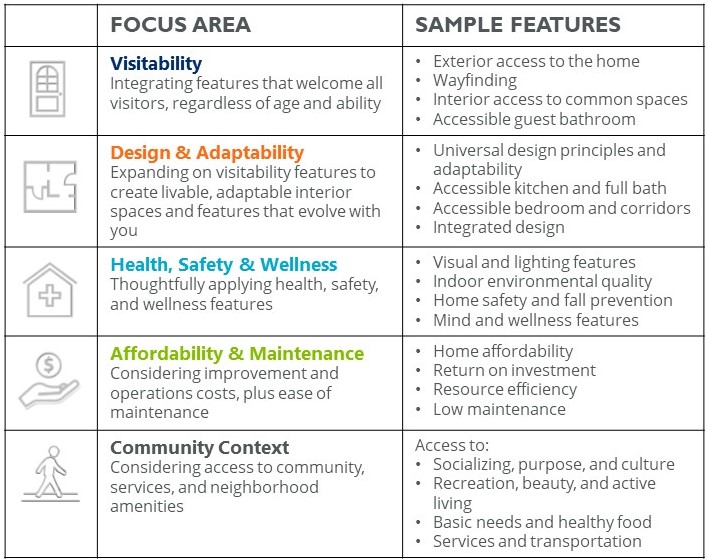The ability to remain within our homes and communities as we navigate life’s changes is still as important as ever. The COVID-19 pandemic has brought this into an even sharper focus as we all spend more time inside our homes. Having a safe, healthy, and accessible home during this public health crisis enables children and families to successfully shelter in place, but also serves as a crucial platform for vulnerable populations, including individuals with disabilities or chronic health conditions and elderly family members.
In Colorado, it is now estimated that nearly 22% of adults live with some type of disability, including issues with mobility, vision, hearing, cognition, and self-care. Many of these adults are part of Colorado’s senior population, which is growing twice as fast as the population at large and is expected to double by 2030. A 2016 Housing Report by the Colorado Governor’s Strategic Action Planning Group on Aging (SAPGA) shows that while there is an overabundance of skilled nursing beds in our State, there is a shortage of appropriate and affordable housing with the necessary features to accommodate successful independent aging and living with disabilities. This adds to an already stressed housing market, especially in the area of affordable housing. The development of residential environments that can be accessed and understood to the greatest extent possible regardless of age, size, and ability, however, has not yet become universal.
Housing options that are equipped to meet the changing needs that come with aging and/or disability, or that incorporate the latest research and thinking on the environmental and social determinants of health, are not keeping pace with the growing need. To better understand these issues, IBE has conducted research and engaged with a number of community organizations, industry partners and municipalities across the state. We are currently engaged in ongoing activities with the Columbine Health Systems Center for Healthy Aging, the Larimer County Partnership for Age-Friendly Communities (PAFC), the City of Centennial, the Rose Community Foundation, Waters’ Edge, LLC., Connell Resources, and New Town Builders to understand the needs and perspectives of many different stakeholders who are working toward the development of better homes and better communities across Colorado. Through these collaborative partnerships, we are engaging stakeholders in envisioning innovative solutions that will fit a broad range of needs and help to incentivize the creation of suitable lifelong housing for all.
IBE has brought together the latest research on the environmental and social determinants of health and has assembled criteria in five categories that re-define what makes homes safe, healthy, and accessible for all.

1-Visitability
All homes should accommodate visitors of any ability. This category addresses the design of residential common spaces and entrances that make it easy for anyone to access a home. Criteria include strategies that better accommodate wheelchairs, walkers, and baby strollers – such as step-free entries, wider door and corridor widths, an accessible guest restroom, and parking accessibility.
2-Design & Adaptability
This category expands on Visitability to design homes that are adaptable and better equipped to support the needs of all current and future residents. Based on Universal Design (UD) concepts, Design & Adaptability features prioritize adaptable, inclusive interior spaces that are livable, functional, and convenient for all ages and abilities. UD strategies account for design that is inclusive, welcoming, and flexible so that a home may be readily adapted as the needs of its inhabitants evolve.
3-Healthy, Safety & Wellness
Many traditional home designs and materials can become unsafe for those experiencing disabilities in mobility, eyesight, or cognition, contributing to increased falls and other safety issues. In addition, materials and home systems choices can have lasting and aggregated effects on our health over time. This category focuses on mitigating health and safety issues with strategies such as slip-resistant flooring, adequate lighting, grab bars, indoor environmental quality measures, and encouragement of clutter-free home environments. In addition, a number of criteria for mindfulness and wellbeing, such as incorporating art and biophilia in the home, are included in this category.
4-Affordability & Maintenance
If the pandemic has shown us anything, it is that anyone can experience unexpected declines in income and/or escalating costs associated with healthcare and necessary home improvement and maintenance. This category considers both the first costs and ongoing operating costs associated with creating and maintaining a suitable home environment. It addresses criteria such as energy efficiency, affordable mortgage or rent costs, and low-maintenance landscaping and materials. In addition, this category considers solutions and strategies involving the overall property rather than just the home, such as adding an accessible Accessory Dwelling Unit (ADU).
5-Community Context
A home is much more than just the interior of a dwelling or even the property on which it is located. This category focuses on the design of the surrounding neighborhood and the availability of amenities around a home. Criteria in this category include strategies such as access to natural spaces, sidewalks, public transportation, and accessible places for socializing, as well as the availability of necessary services.
~~~
While the Colorado Lifelong Homes Initiative is still under development, these five key categories provide a framework for what we consider crucial components of any lifelong home. Our continued partners (and those yet to be engaged) will help us refine the criteria most critical within each category. They will also help define how these criteria should be weighted to make the program meaningful while still feasible in terms of cost, effort, and time. Issues are likely to be different for different types of projects (e.g., new vs. existing, single-family vs. multifamily, etc.) and different areas of Colorado (e.g., urban, suburban, rural), and we continue to seek partners to provide feedback on the program from a variety of perspectives.
If you are interested in learning more about the Colorado Lifelong Homes Certification Program or in becoming a partner, please contact me to help us bring this initiative to fruition!

